A Transport of Delight
“Show a bit of lace!”, the advertisement cajoled, urging female listeners to buy a particular brand of knickers. No, this wasn’t a new ad on China’s CCTV; nor even a spot on London’s Capital Radio. It certainly wasn’t aired on any of the stations broadcasting in the Arabian Gulf!
Instead, my mind was taken back nearly 50 years to the heady days of Mary Quant’s mini skirt revolution, with stylish fashionistas in London’s Carnaby Street leading the world in all things trendy; and to this particular advertisement aired on the now defunct English language service of Radio Luxembourg.
The reasoning was flawless. With mini skirts now all the rage, coupled with London’s penchant for double decker buses, the chic young things of the time could well have had a problem going up the stairs on the buses wearing their mini skirts. But were they to wear these trendy knickers, then their problems would be solved!
I remember at the time thinking how useful they would have been for Alice in her Wonderland racing after the White Rabbit and falling down…down…down into his bunny hole. What if Mr Wabbit had looked up over his shoulder and actually caught a glimpse of her bottom! Heavens above! Could she have used a pair of those frilly knickers!
I have been reminded of this advertisement quite recently, having arrived in the Chinese capital during the summer heat wave so typical of Beijing. The vast majority of young girls here wear either ultra short skirts or culottes, designed to look like skirts, and show off their legs to great effect.
And that is all very well, but like London’s double decker buses, Beijing’s metro system can cause the female sorority something of a problem. The underground railway is a superb complex of engineering, with many of the stations deep below ground level. This means that there are very many stairs (going down) and very steep escalators (going up) with the result that females tend to adopt a classic pose, as they ride the escalators, of placing the back of their hand against their bottom to ensure that they aren’t caught in a Marilyn Monroe moment as a gust of wind from the depths of the metro reveals too much in the way of eye candy for the appreciative males - although guys being guys the world over, this doesn’t stop them from craning their necks to see what little there is to see!
Beijing’s metro is a wonderful place for people watching. And I have to say I’m quite a fan of the subway system here. There are 14 lines in all, 336 km of tracks and 172 stations. By 2015 the city predicts daily ridership (is that a word???) will increase to over 8 million journeys a day when the city will have 19 subway lines and 561 km in track length. This will make Beijing's subway system one of the largest in the world.
For just 2RMB – around 19 pence or 25¢ - you can travel from one end of Beijing to the other from around 5am to nearly midnight. It doesn’t matter how far you travel – be it just one stop or the entire length of the line … and then some, it will still cost you just 2 RMB. Of course, you will be damned lucky to ever get a seat unless you start off at the end of the line.
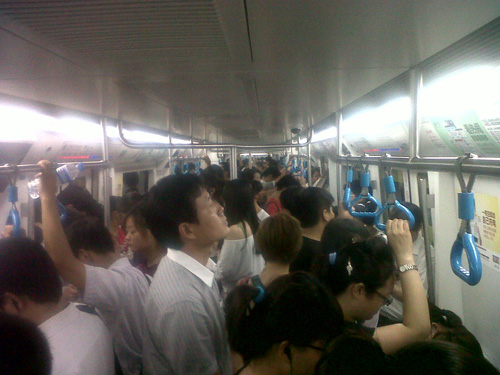
The above photo was taken at 11 in the morning. A relatively empty carriage as you can see. I mean you even have room to breathe without having someone’s left armpit shoved up your nostril (although being a western expat does have its advantages in this regard). The photo below was taken at 4 in the afternoon.
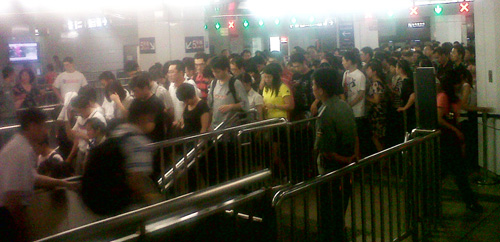
Probably the best time to travel, therefore is around 5.30am or after 10 at night.
But apart from the crowds, it is simplicity itself to find your way around. Notices are written both in Chinese and Pinyin.
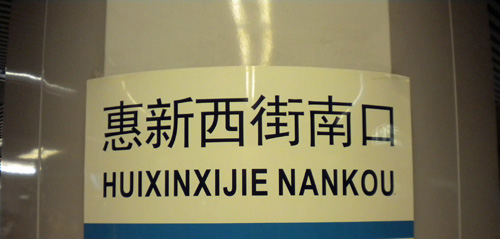
(Try saying that in a hurry when you have had a couple over the limit!)
And on board there are adequate displays of where on the line you are and what the next station is likely to be.
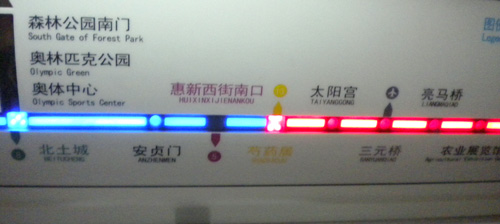
On the platforms there are TV sets to make sure you don’t get bored during the 4-5 minutes you might have to wait between trains (the Chinese love their TVs and you will find them everywhere – in lifts, in lobby areas, in shopping centres, in the streets, in stations… it seems no one can live without a feed of some entertainment channel or other, all interspersed with infomercials at every turn).
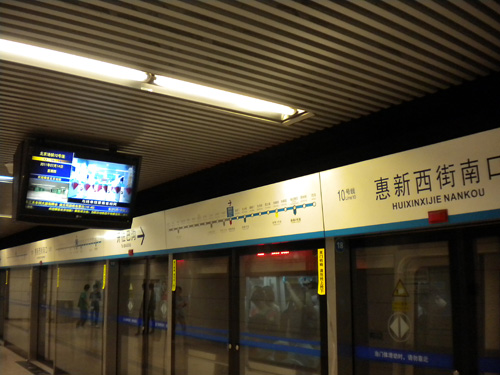
Well, these TVs obviously work as the well mannered Chinese patiently queue up in front of the doors waiting for their train while being fed with live feeds from some sporting event, or a rock concert, or whatever.
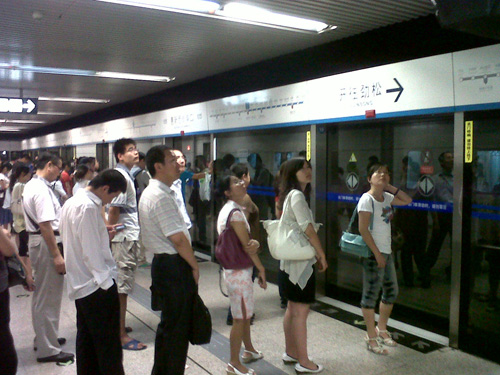
Of course, life wouldn’t be fun without the occasional googly thrown at you when you are least expecting it. My local Carrefour store is 200m from a station called Jiandemen – three stops along line 10 from my home station of Huixinxijie Nankou. Carrefour is on the north east corner of the cross roads, so thought I, it might seem a bit obvious to make an exit from Exit B – north east.
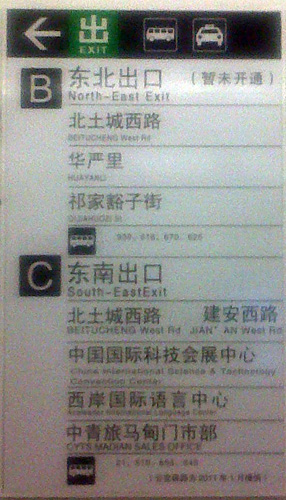
So as everyone traipsed off the train and headed for exit C or A (no-one seemed interested in exit D for some reason) guess who spent a good five minutes wandering from one end of the platform to the other searching for Exit B!
I counted four signs to Exit B, but whenever I approached where I thought it should be, there was another notice pointing in the opposite direction. Eventually I gave up the unequal struggle and headed for Exit C with the latest exodus of passengers, only to discover once upstairs that there was in fact no exit B in existence.
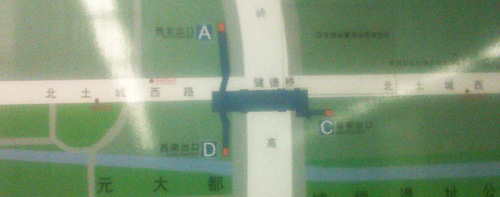
I wonder if the guys monitoring the closed circuit TV cameras (of which China must have more than anywhere else in the world put together) have a good laugh seeing the puzzled expats searching for a non existent exit? Well, as long as I made someone happy that day, then who am I to complain! **
I said that you could go anywhere on the subway system for 2 yuan, but in fact this isn’t quite true. There is one line only on which the fare is 25¥ and this is the Airport Express which has four stations on it – Terminal 1&2 / Terminal 3 / Sanyuanqiao (with a convenient interchange for line10) and the end of the line at Dongzhimen.
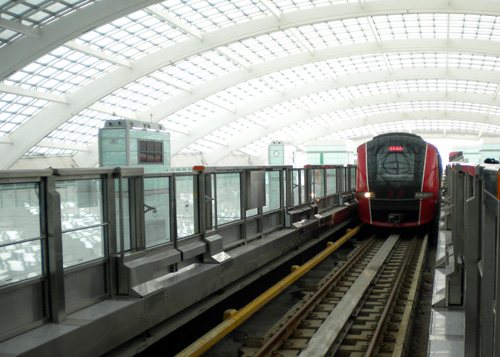
It’s all very well if you want to go into town from the airport or indeed if you want to go from T3 to T2. But should you want to use the Express to go from T2 to T3, then you are obliged to take the 20 minute ride into town first from T2 and then go out again (another 20 minutes) to T3.
And a word to the wise – if you like to travel facing forward on a train, rather than sitting with your back to the engine, so to speak, you should be aware that the train travels push-me-pull-you style; so if you are facing forward from town to T3, you will be facing backwards from T3 to T2 and then forwards again from T2 into town again… which explains the mad game of musical chairs as you pull into one of the stations.
If you think that the metro is a good deal, then wait till you try the buses! A standard journey to anywhere will cost a mere 1¥… but wait a minute – it gets better. Avail yourself of a Beijing Public Transport Holdings, Ltd. smart card issued from the Beijing Municipal Administration and Communication Card Company, but obtainable from most subway stations (similar to London’s Oyster Card, Hong Kong’s Octopus or Dubai’s Nol Card) and a bus journey costs not 1¥ but 4 Jiao (that’s 0.4¥). And being proud of my Scottish heritage, not to mention my adopted home of Yorkshire (where they say the men have short arms and long pockets) you might wonder why I ever even bother with the metro when the buses are so cheap.
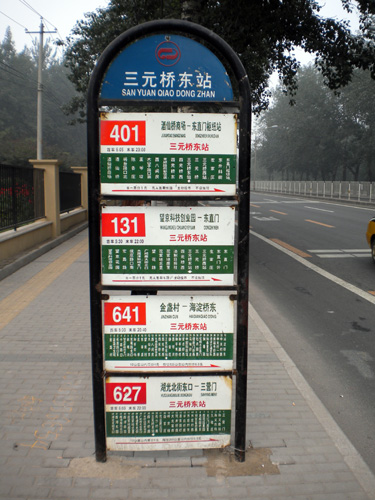
But one look at a bus stop might well explain that conundrum, though that I know is a poor excuse. I mean there’s a perfectly good web site containing bus maps, and even a service where you type in your start and end points and it tells you which bus(es) to take. What could be easier? Or rather, what could be easier if you can type in Chinese? There is no Pinyin equivalent, unfortunately.
So I have now made a start of religiously typing into my Blackberry the bus numbers on the stops whenever I get to a new place that I feel I might want to visit again. Eventually, my incredible brain has worked out, I will be able to join up connecting bus numbers and thereby save myself a fortune.
Not that you’re ever likely to overspend on transport here. Take the taxis, for instance. In the old days (up to three or four years ago) there were three types of taxi charging 1.2¥, 1.6¥ or 2¥ per kilometre depending on whether the car was a Xiali, a Citroen or a Volkswagen. Nowadays, all the taxis are either Volkswagen Jetta or Hyundai Elektra and they all charge the same 2¥ rate.

Whatever taxi company they operate with, you can tell them at a glance by their bright yellow stripe, regardless of whether the main body colour is blue, red, orange, green, brown or whatever.
A typical 15 minute journey is going to set you back around 10¥ although since the latest oil price hike, drivers will normally add on an extra yuan once the meter goes above 10. Most of the taxis are well showing their age, but they are plentiful and quite convenient, though not one driver in the whole of Beijing speaks a single word of English (I believe this is a prerequisite written into their contract to allow them to drive at all) and the only way to communicate is to have your destination written down in Chinese and wave this piece of paper under your driver’s nose.
One enterprising publishing house has even brought out a wire-bound flip-book with over 400 destinations written in both languages together with some “useful Chinese phrases” (I wonder if they include ‘I say my good man, would you be everso kind and turn on your air conditioning?’ or ‘Perhaps you could desist from spitting out the window every time you reach a traffic light?’)
Rather beguilingly, the advertisement for the book, which appears in virtually every expat magazine, features a Beijing cab approaching a red sand dune across which two Bedouin on camels are plodding with ‘Does your driver know the way’ splashed across the blue sky. Takes me straight back to the days when I would regularly drive across the Empty Quarter from Riyadh to Dubai.
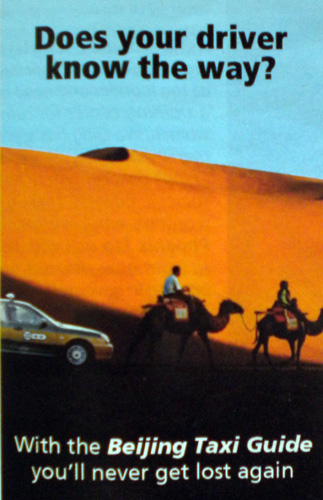
If the Beijing taxis are too staid for your ingrained sense of adventure, then maybe a bike cab would be more to your way of thinking? They operate only in their own little locality, and apparently you have to negotiate a reasonable fare before you start the journey which is the main reason I haven’t (so far) plucked up the nerve to try one out. But give me time. They look a whole load of fun.
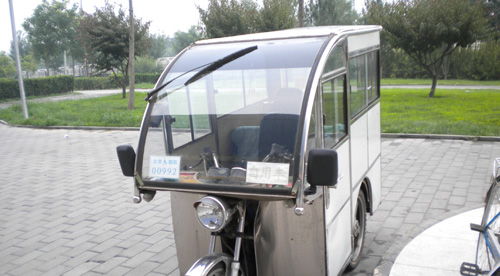
Of course, at the opposite end of the scale for longer distances are the many train lines that operate out of Beijing. The capital has three main railway stations: Beijing Railway Station, Beijing West Railway Station and Beijing South Railway Station. These latter two are among the biggest railway stations in the world as I can testify from my journey a couple of weeks back to Tianjin. Truly Beijing South was a place you could easily get lost in. On my return in the evening I didn’t recognise any landmarks within the station itself from when I had passed through that morning.
There are other stations in Beijing too, of course. For instance how about Beijing East or even Beijing North? (I am convinced that somewhere in China there is a naming committee that deliberated long and hard to come up with such names.)
It was from Beijing South that I took the bullet train to Tanjin. It was a sleak, ultra clean, ultra comfortable and ultra fast train that was simply a joy to travel on.
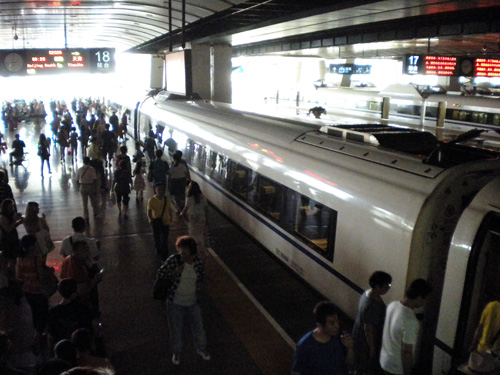
Unfortunately since the roll out of the high speed connection from Beijing to Shanghai earlier this month, the high speed railway has suffered one misfortune after another. A high speed train heading for Shanghai halted for over two hours in Jinan only 10 days after the line’s debut. Another five malfunctions occurred in the next four days raising doubts about the safety of the trains.
But on July 23rd a fatal collision occurred after a train was struck by lightning when crossing a bridge at Wenzhou, Zhejiang, and was then rear ended by a second train resulting in the death of at least 39 people with 192 injured. Four of the carriages of the first train even plunged off the bridge. Not surprisingly the issue has been front page news for a week now and has put the entire future of the high speed rail network in doubt.
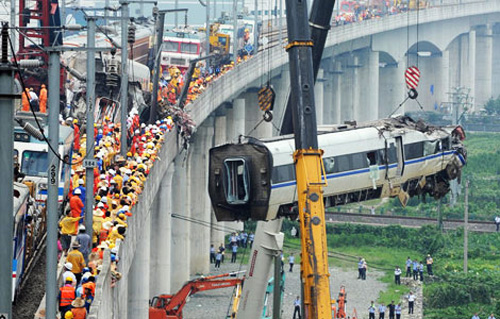
Three top railway officials were promptly sacked as it was revealed that the trains have no automatic braking system, meaning that the driver himself has to apply the brakes in the event of an emergency. And later in the week it was revealed that signals that should automatically have turned red failed to respond to the presence of the stopped train up ahead.
Passengers have been cancelling their prepaid tickets in droves and the regional airlines have been having a field day as their share prices have shot up in contrast to railway companies that have seen their market valuations plummet.
Beijing municipality has ordered a strengthening of safety procedures on the city's subway network in the wake of the fatal crash and stressed the four requirements for safe subway operation: carriages should not be overloaded, platforms not overcrowded, passages not over-congested, and escalators not operating at full capacity.
Statistics published last Friday by Beijing Subway showed more than 6.2 million journeys were made on July 15th, creating a new record, adding that the metro’s passenger capacity had reached its limit.
So it will be interesting to see what, if anything changes when riding the metro network around Beijing in the near future.
But one thing, I think I can safely predict with near certainty is that as long as the hot weather lasts, Beijing’s male population will continue to enjoy the numerous examples of eye candy riding the city subway’s escalators!
** Addendum 01/08/11: I am indebted to my friend Mei Ling for pointing out what I had signally failed to see when following sign B: 暂 means "Yet"; 未 = Not; 开通 = Open. Oh, Silly Me!!!
